Dental Indemnity Insurance: Knowledge, Practice, and Attitude
VerifiedAdded on 2022/08/21
|16
|4240
|14
Report
AI Summary
This report provides a comprehensive review of dental indemnity insurance, examining the attitudes, practices, and knowledge of healthcare professionals regarding professional indemnity. The study explores the significance of dental indemnity insurance in protecting dentists from legal issues arising from malpractice, misdiagnosis, or errors in treatment. It reviews the theoretical framework and literature, including studies on dentists' awareness of insurance policies, informed consent, and medico-legal issues. The report also discusses medical errors and liability in Saudi Arabia, comparing litigation processes and highlighting the need for improved medical professional liability. Key findings reveal that while awareness of informed consent is high, knowledge of indemnity insurance and consumer protection acts may be lacking among healthcare professionals. The analysis emphasizes the importance of spreading awareness about medical law and ethics to reduce medical errors and enhance patient care.
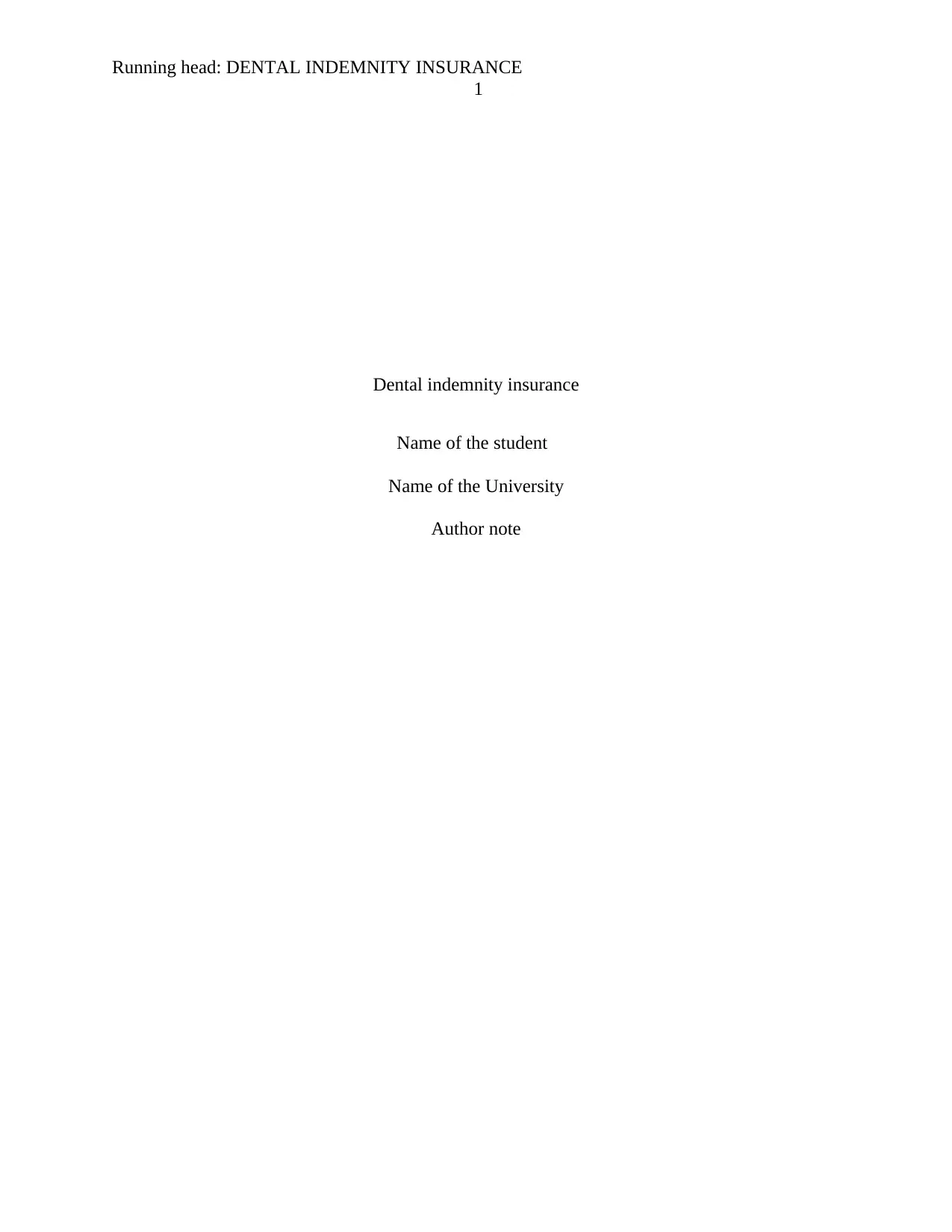
Running head: DENTAL INDEMNITY INSURANCE
1
Dental indemnity insurance
Name of the student
Name of the University
Author note
1
Dental indemnity insurance
Name of the student
Name of the University
Author note
Paraphrase This Document
Need a fresh take? Get an instant paraphrase of this document with our AI Paraphraser
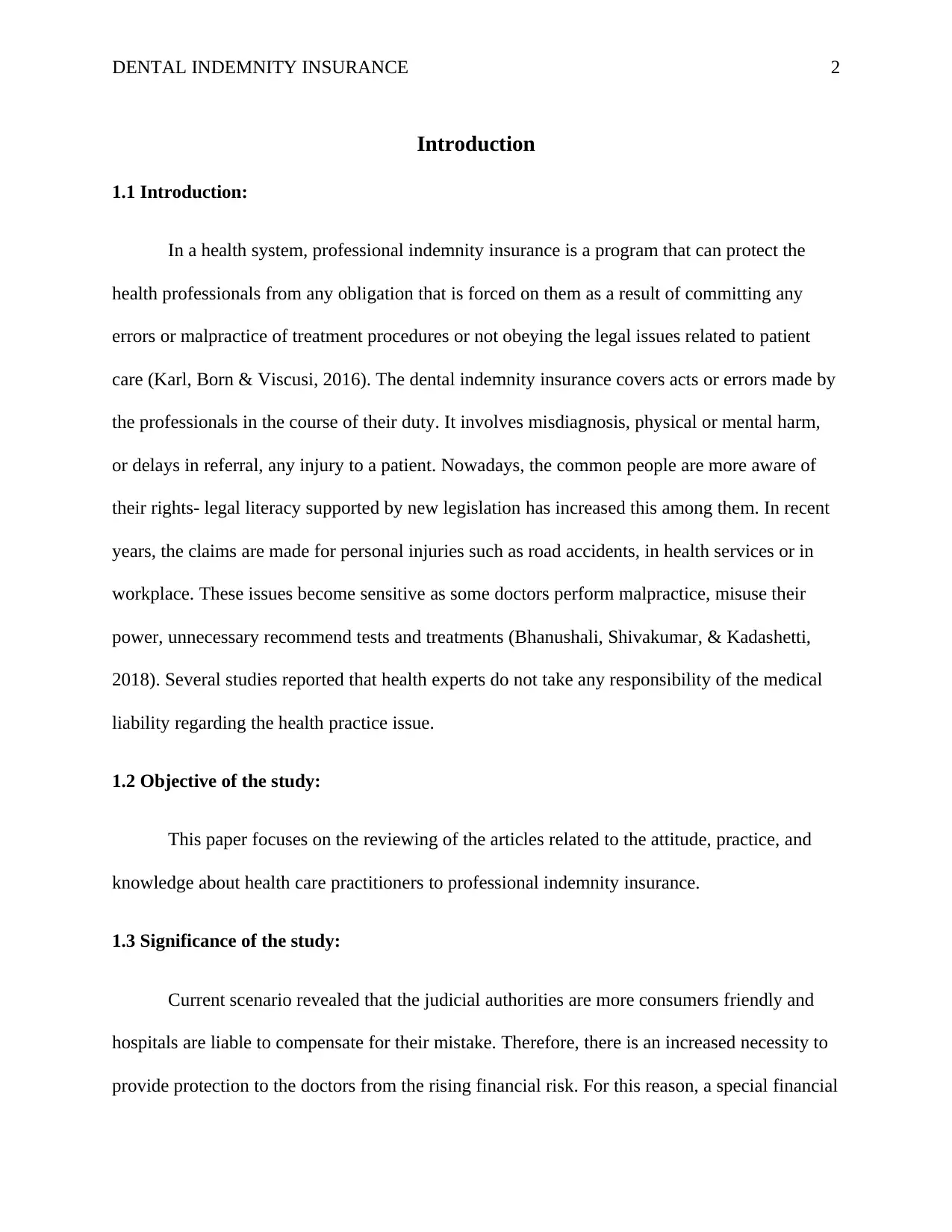
DENTAL INDEMNITY INSURANCE 2
Introduction
1.1 Introduction:
In a health system, professional indemnity insurance is a program that can protect the
health professionals from any obligation that is forced on them as a result of committing any
errors or malpractice of treatment procedures or not obeying the legal issues related to patient
care (Karl, Born & Viscusi, 2016). The dental indemnity insurance covers acts or errors made by
the professionals in the course of their duty. It involves misdiagnosis, physical or mental harm,
or delays in referral, any injury to a patient. Nowadays, the common people are more aware of
their rights- legal literacy supported by new legislation has increased this among them. In recent
years, the claims are made for personal injuries such as road accidents, in health services or in
workplace. These issues become sensitive as some doctors perform malpractice, misuse their
power, unnecessary recommend tests and treatments (Bhanushali, Shivakumar, & Kadashetti,
2018). Several studies reported that health experts do not take any responsibility of the medical
liability regarding the health practice issue.
1.2 Objective of the study:
This paper focuses on the reviewing of the articles related to the attitude, practice, and
knowledge about health care practitioners to professional indemnity insurance.
1.3 Significance of the study:
Current scenario revealed that the judicial authorities are more consumers friendly and
hospitals are liable to compensate for their mistake. Therefore, there is an increased necessity to
provide protection to the doctors from the rising financial risk. For this reason, a special financial
Introduction
1.1 Introduction:
In a health system, professional indemnity insurance is a program that can protect the
health professionals from any obligation that is forced on them as a result of committing any
errors or malpractice of treatment procedures or not obeying the legal issues related to patient
care (Karl, Born & Viscusi, 2016). The dental indemnity insurance covers acts or errors made by
the professionals in the course of their duty. It involves misdiagnosis, physical or mental harm,
or delays in referral, any injury to a patient. Nowadays, the common people are more aware of
their rights- legal literacy supported by new legislation has increased this among them. In recent
years, the claims are made for personal injuries such as road accidents, in health services or in
workplace. These issues become sensitive as some doctors perform malpractice, misuse their
power, unnecessary recommend tests and treatments (Bhanushali, Shivakumar, & Kadashetti,
2018). Several studies reported that health experts do not take any responsibility of the medical
liability regarding the health practice issue.
1.2 Objective of the study:
This paper focuses on the reviewing of the articles related to the attitude, practice, and
knowledge about health care practitioners to professional indemnity insurance.
1.3 Significance of the study:
Current scenario revealed that the judicial authorities are more consumers friendly and
hospitals are liable to compensate for their mistake. Therefore, there is an increased necessity to
provide protection to the doctors from the rising financial risk. For this reason, a special financial
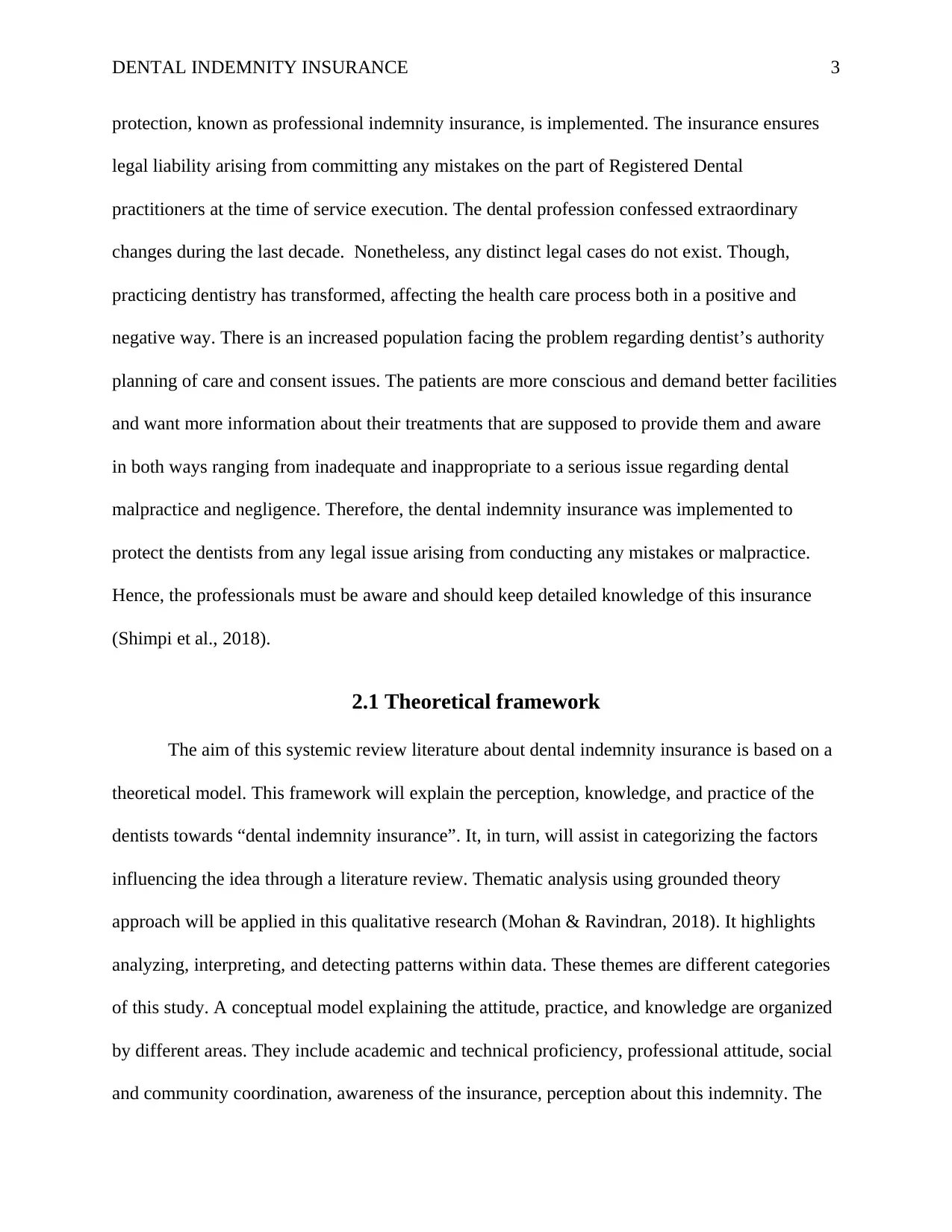
DENTAL INDEMNITY INSURANCE 3
protection, known as professional indemnity insurance, is implemented. The insurance ensures
legal liability arising from committing any mistakes on the part of Registered Dental
practitioners at the time of service execution. The dental profession confessed extraordinary
changes during the last decade. Nonetheless, any distinct legal cases do not exist. Though,
practicing dentistry has transformed, affecting the health care process both in a positive and
negative way. There is an increased population facing the problem regarding dentist’s authority
planning of care and consent issues. The patients are more conscious and demand better facilities
and want more information about their treatments that are supposed to provide them and aware
in both ways ranging from inadequate and inappropriate to a serious issue regarding dental
malpractice and negligence. Therefore, the dental indemnity insurance was implemented to
protect the dentists from any legal issue arising from conducting any mistakes or malpractice.
Hence, the professionals must be aware and should keep detailed knowledge of this insurance
(Shimpi et al., 2018).
2.1 Theoretical framework
The aim of this systemic review literature about dental indemnity insurance is based on a
theoretical model. This framework will explain the perception, knowledge, and practice of the
dentists towards “dental indemnity insurance”. It, in turn, will assist in categorizing the factors
influencing the idea through a literature review. Thematic analysis using grounded theory
approach will be applied in this qualitative research (Mohan & Ravindran, 2018). It highlights
analyzing, interpreting, and detecting patterns within data. These themes are different categories
of this study. A conceptual model explaining the attitude, practice, and knowledge are organized
by different areas. They include academic and technical proficiency, professional attitude, social
and community coordination, awareness of the insurance, perception about this indemnity. The
protection, known as professional indemnity insurance, is implemented. The insurance ensures
legal liability arising from committing any mistakes on the part of Registered Dental
practitioners at the time of service execution. The dental profession confessed extraordinary
changes during the last decade. Nonetheless, any distinct legal cases do not exist. Though,
practicing dentistry has transformed, affecting the health care process both in a positive and
negative way. There is an increased population facing the problem regarding dentist’s authority
planning of care and consent issues. The patients are more conscious and demand better facilities
and want more information about their treatments that are supposed to provide them and aware
in both ways ranging from inadequate and inappropriate to a serious issue regarding dental
malpractice and negligence. Therefore, the dental indemnity insurance was implemented to
protect the dentists from any legal issue arising from conducting any mistakes or malpractice.
Hence, the professionals must be aware and should keep detailed knowledge of this insurance
(Shimpi et al., 2018).
2.1 Theoretical framework
The aim of this systemic review literature about dental indemnity insurance is based on a
theoretical model. This framework will explain the perception, knowledge, and practice of the
dentists towards “dental indemnity insurance”. It, in turn, will assist in categorizing the factors
influencing the idea through a literature review. Thematic analysis using grounded theory
approach will be applied in this qualitative research (Mohan & Ravindran, 2018). It highlights
analyzing, interpreting, and detecting patterns within data. These themes are different categories
of this study. A conceptual model explaining the attitude, practice, and knowledge are organized
by different areas. They include academic and technical proficiency, professional attitude, social
and community coordination, awareness of the insurance, perception about this indemnity. The
⊘ This is a preview!⊘
Do you want full access?
Subscribe today to unlock all pages.

Trusted by 1+ million students worldwide
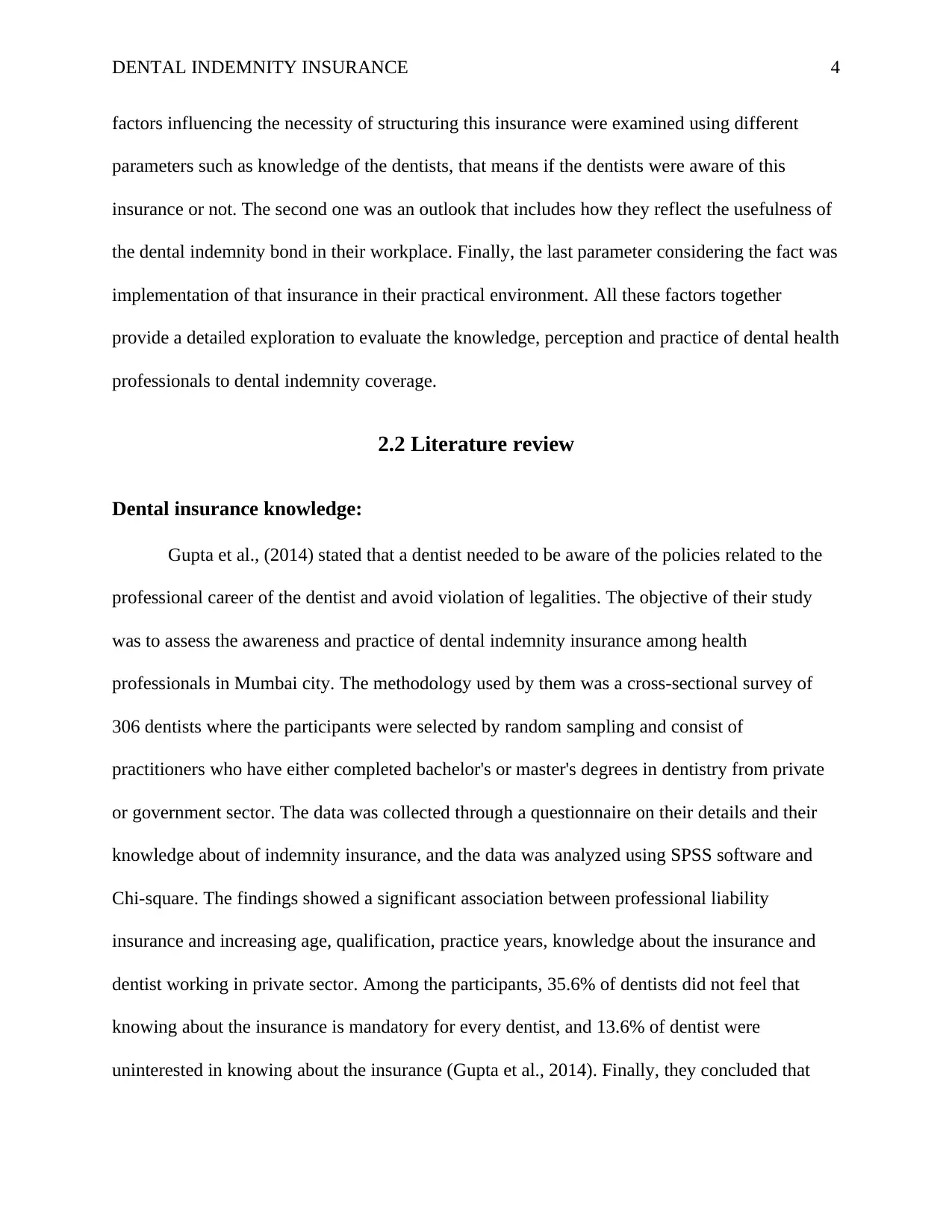
DENTAL INDEMNITY INSURANCE 4
factors influencing the necessity of structuring this insurance were examined using different
parameters such as knowledge of the dentists, that means if the dentists were aware of this
insurance or not. The second one was an outlook that includes how they reflect the usefulness of
the dental indemnity bond in their workplace. Finally, the last parameter considering the fact was
implementation of that insurance in their practical environment. All these factors together
provide a detailed exploration to evaluate the knowledge, perception and practice of dental health
professionals to dental indemnity coverage.
2.2 Literature review
Dental insurance knowledge:
Gupta et al., (2014) stated that a dentist needed to be aware of the policies related to the
professional career of the dentist and avoid violation of legalities. The objective of their study
was to assess the awareness and practice of dental indemnity insurance among health
professionals in Mumbai city. The methodology used by them was a cross-sectional survey of
306 dentists where the participants were selected by random sampling and consist of
practitioners who have either completed bachelor's or master's degrees in dentistry from private
or government sector. The data was collected through a questionnaire on their details and their
knowledge about of indemnity insurance, and the data was analyzed using SPSS software and
Chi-square. The findings showed a significant association between professional liability
insurance and increasing age, qualification, practice years, knowledge about the insurance and
dentist working in private sector. Among the participants, 35.6% of dentists did not feel that
knowing about the insurance is mandatory for every dentist, and 13.6% of dentist were
uninterested in knowing about the insurance (Gupta et al., 2014). Finally, they concluded that
factors influencing the necessity of structuring this insurance were examined using different
parameters such as knowledge of the dentists, that means if the dentists were aware of this
insurance or not. The second one was an outlook that includes how they reflect the usefulness of
the dental indemnity bond in their workplace. Finally, the last parameter considering the fact was
implementation of that insurance in their practical environment. All these factors together
provide a detailed exploration to evaluate the knowledge, perception and practice of dental health
professionals to dental indemnity coverage.
2.2 Literature review
Dental insurance knowledge:
Gupta et al., (2014) stated that a dentist needed to be aware of the policies related to the
professional career of the dentist and avoid violation of legalities. The objective of their study
was to assess the awareness and practice of dental indemnity insurance among health
professionals in Mumbai city. The methodology used by them was a cross-sectional survey of
306 dentists where the participants were selected by random sampling and consist of
practitioners who have either completed bachelor's or master's degrees in dentistry from private
or government sector. The data was collected through a questionnaire on their details and their
knowledge about of indemnity insurance, and the data was analyzed using SPSS software and
Chi-square. The findings showed a significant association between professional liability
insurance and increasing age, qualification, practice years, knowledge about the insurance and
dentist working in private sector. Among the participants, 35.6% of dentists did not feel that
knowing about the insurance is mandatory for every dentist, and 13.6% of dentist were
uninterested in knowing about the insurance (Gupta et al., 2014). Finally, they concluded that
Paraphrase This Document
Need a fresh take? Get an instant paraphrase of this document with our AI Paraphraser
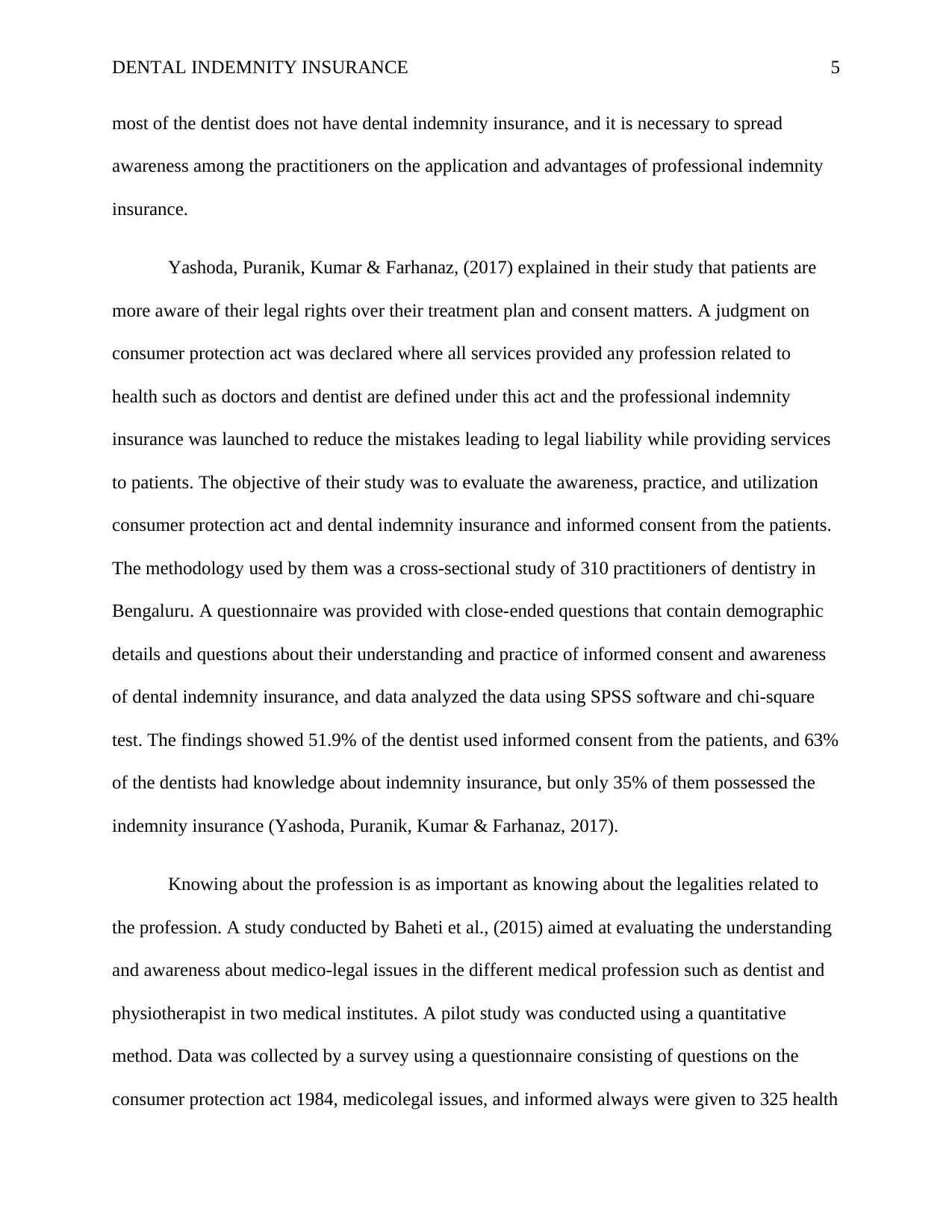
DENTAL INDEMNITY INSURANCE 5
most of the dentist does not have dental indemnity insurance, and it is necessary to spread
awareness among the practitioners on the application and advantages of professional indemnity
insurance.
Yashoda, Puranik, Kumar & Farhanaz, (2017) explained in their study that patients are
more aware of their legal rights over their treatment plan and consent matters. A judgment on
consumer protection act was declared where all services provided any profession related to
health such as doctors and dentist are defined under this act and the professional indemnity
insurance was launched to reduce the mistakes leading to legal liability while providing services
to patients. The objective of their study was to evaluate the awareness, practice, and utilization
consumer protection act and dental indemnity insurance and informed consent from the patients.
The methodology used by them was a cross-sectional study of 310 practitioners of dentistry in
Bengaluru. A questionnaire was provided with close-ended questions that contain demographic
details and questions about their understanding and practice of informed consent and awareness
of dental indemnity insurance, and data analyzed the data using SPSS software and chi-square
test. The findings showed 51.9% of the dentist used informed consent from the patients, and 63%
of the dentists had knowledge about indemnity insurance, but only 35% of them possessed the
indemnity insurance (Yashoda, Puranik, Kumar & Farhanaz, 2017).
Knowing about the profession is as important as knowing about the legalities related to
the profession. A study conducted by Baheti et al., (2015) aimed at evaluating the understanding
and awareness about medico-legal issues in the different medical profession such as dentist and
physiotherapist in two medical institutes. A pilot study was conducted using a quantitative
method. Data was collected by a survey using a questionnaire consisting of questions on the
consumer protection act 1984, medicolegal issues, and informed always were given to 325 health
most of the dentist does not have dental indemnity insurance, and it is necessary to spread
awareness among the practitioners on the application and advantages of professional indemnity
insurance.
Yashoda, Puranik, Kumar & Farhanaz, (2017) explained in their study that patients are
more aware of their legal rights over their treatment plan and consent matters. A judgment on
consumer protection act was declared where all services provided any profession related to
health such as doctors and dentist are defined under this act and the professional indemnity
insurance was launched to reduce the mistakes leading to legal liability while providing services
to patients. The objective of their study was to evaluate the awareness, practice, and utilization
consumer protection act and dental indemnity insurance and informed consent from the patients.
The methodology used by them was a cross-sectional study of 310 practitioners of dentistry in
Bengaluru. A questionnaire was provided with close-ended questions that contain demographic
details and questions about their understanding and practice of informed consent and awareness
of dental indemnity insurance, and data analyzed the data using SPSS software and chi-square
test. The findings showed 51.9% of the dentist used informed consent from the patients, and 63%
of the dentists had knowledge about indemnity insurance, but only 35% of them possessed the
indemnity insurance (Yashoda, Puranik, Kumar & Farhanaz, 2017).
Knowing about the profession is as important as knowing about the legalities related to
the profession. A study conducted by Baheti et al., (2015) aimed at evaluating the understanding
and awareness about medico-legal issues in the different medical profession such as dentist and
physiotherapist in two medical institutes. A pilot study was conducted using a quantitative
method. Data was collected by a survey using a questionnaire consisting of questions on the
consumer protection act 1984, medicolegal issues, and informed always were given to 325 health
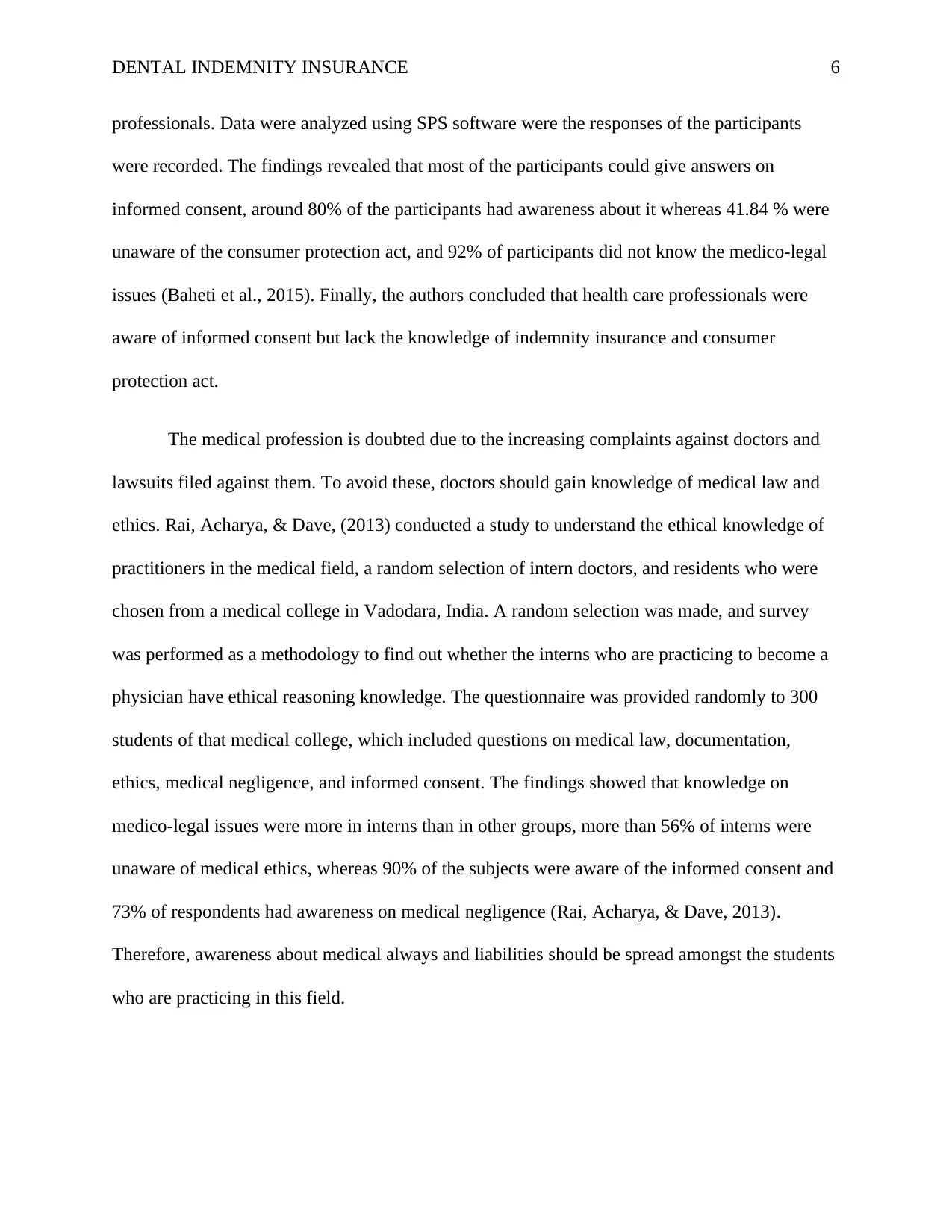
DENTAL INDEMNITY INSURANCE 6
professionals. Data were analyzed using SPS software were the responses of the participants
were recorded. The findings revealed that most of the participants could give answers on
informed consent, around 80% of the participants had awareness about it whereas 41.84 % were
unaware of the consumer protection act, and 92% of participants did not know the medico-legal
issues (Baheti et al., 2015). Finally, the authors concluded that health care professionals were
aware of informed consent but lack the knowledge of indemnity insurance and consumer
protection act.
The medical profession is doubted due to the increasing complaints against doctors and
lawsuits filed against them. To avoid these, doctors should gain knowledge of medical law and
ethics. Rai, Acharya, & Dave, (2013) conducted a study to understand the ethical knowledge of
practitioners in the medical field, a random selection of intern doctors, and residents who were
chosen from a medical college in Vadodara, India. A random selection was made, and survey
was performed as a methodology to find out whether the interns who are practicing to become a
physician have ethical reasoning knowledge. The questionnaire was provided randomly to 300
students of that medical college, which included questions on medical law, documentation,
ethics, medical negligence, and informed consent. The findings showed that knowledge on
medico-legal issues were more in interns than in other groups, more than 56% of interns were
unaware of medical ethics, whereas 90% of the subjects were aware of the informed consent and
73% of respondents had awareness on medical negligence (Rai, Acharya, & Dave, 2013).
Therefore, awareness about medical always and liabilities should be spread amongst the students
who are practicing in this field.
professionals. Data were analyzed using SPS software were the responses of the participants
were recorded. The findings revealed that most of the participants could give answers on
informed consent, around 80% of the participants had awareness about it whereas 41.84 % were
unaware of the consumer protection act, and 92% of participants did not know the medico-legal
issues (Baheti et al., 2015). Finally, the authors concluded that health care professionals were
aware of informed consent but lack the knowledge of indemnity insurance and consumer
protection act.
The medical profession is doubted due to the increasing complaints against doctors and
lawsuits filed against them. To avoid these, doctors should gain knowledge of medical law and
ethics. Rai, Acharya, & Dave, (2013) conducted a study to understand the ethical knowledge of
practitioners in the medical field, a random selection of intern doctors, and residents who were
chosen from a medical college in Vadodara, India. A random selection was made, and survey
was performed as a methodology to find out whether the interns who are practicing to become a
physician have ethical reasoning knowledge. The questionnaire was provided randomly to 300
students of that medical college, which included questions on medical law, documentation,
ethics, medical negligence, and informed consent. The findings showed that knowledge on
medico-legal issues were more in interns than in other groups, more than 56% of interns were
unaware of medical ethics, whereas 90% of the subjects were aware of the informed consent and
73% of respondents had awareness on medical negligence (Rai, Acharya, & Dave, 2013).
Therefore, awareness about medical always and liabilities should be spread amongst the students
who are practicing in this field.
⊘ This is a preview!⊘
Do you want full access?
Subscribe today to unlock all pages.

Trusted by 1+ million students worldwide
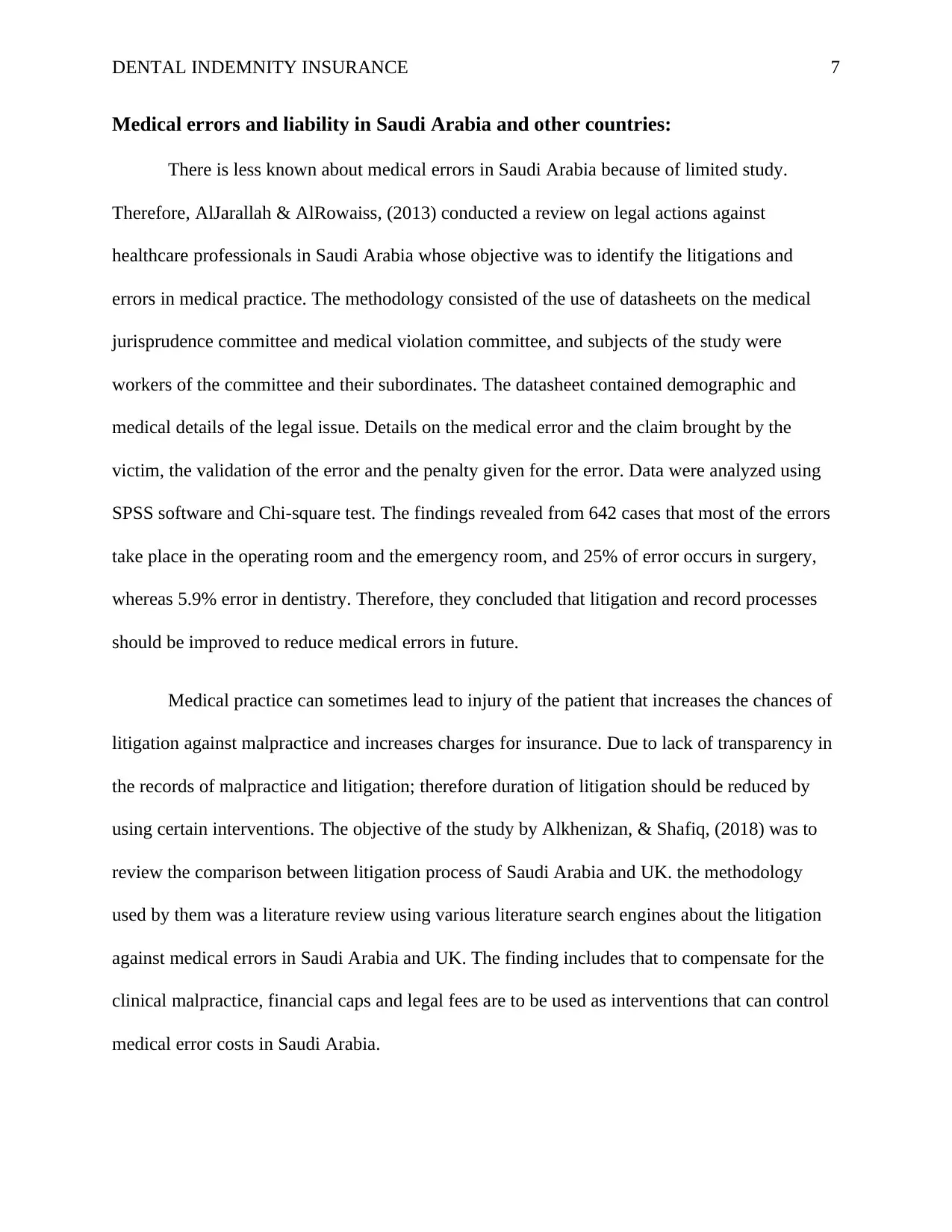
DENTAL INDEMNITY INSURANCE 7
Medical errors and liability in Saudi Arabia and other countries:
There is less known about medical errors in Saudi Arabia because of limited study.
Therefore, AlJarallah & AlRowaiss, (2013) conducted a review on legal actions against
healthcare professionals in Saudi Arabia whose objective was to identify the litigations and
errors in medical practice. The methodology consisted of the use of datasheets on the medical
jurisprudence committee and medical violation committee, and subjects of the study were
workers of the committee and their subordinates. The datasheet contained demographic and
medical details of the legal issue. Details on the medical error and the claim brought by the
victim, the validation of the error and the penalty given for the error. Data were analyzed using
SPSS software and Chi-square test. The findings revealed from 642 cases that most of the errors
take place in the operating room and the emergency room, and 25% of error occurs in surgery,
whereas 5.9% error in dentistry. Therefore, they concluded that litigation and record processes
should be improved to reduce medical errors in future.
Medical practice can sometimes lead to injury of the patient that increases the chances of
litigation against malpractice and increases charges for insurance. Due to lack of transparency in
the records of malpractice and litigation; therefore duration of litigation should be reduced by
using certain interventions. The objective of the study by Alkhenizan, & Shafiq, (2018) was to
review the comparison between litigation process of Saudi Arabia and UK. the methodology
used by them was a literature review using various literature search engines about the litigation
against medical errors in Saudi Arabia and UK. The finding includes that to compensate for the
clinical malpractice, financial caps and legal fees are to be used as interventions that can control
medical error costs in Saudi Arabia.
Medical errors and liability in Saudi Arabia and other countries:
There is less known about medical errors in Saudi Arabia because of limited study.
Therefore, AlJarallah & AlRowaiss, (2013) conducted a review on legal actions against
healthcare professionals in Saudi Arabia whose objective was to identify the litigations and
errors in medical practice. The methodology consisted of the use of datasheets on the medical
jurisprudence committee and medical violation committee, and subjects of the study were
workers of the committee and their subordinates. The datasheet contained demographic and
medical details of the legal issue. Details on the medical error and the claim brought by the
victim, the validation of the error and the penalty given for the error. Data were analyzed using
SPSS software and Chi-square test. The findings revealed from 642 cases that most of the errors
take place in the operating room and the emergency room, and 25% of error occurs in surgery,
whereas 5.9% error in dentistry. Therefore, they concluded that litigation and record processes
should be improved to reduce medical errors in future.
Medical practice can sometimes lead to injury of the patient that increases the chances of
litigation against malpractice and increases charges for insurance. Due to lack of transparency in
the records of malpractice and litigation; therefore duration of litigation should be reduced by
using certain interventions. The objective of the study by Alkhenizan, & Shafiq, (2018) was to
review the comparison between litigation process of Saudi Arabia and UK. the methodology
used by them was a literature review using various literature search engines about the litigation
against medical errors in Saudi Arabia and UK. The finding includes that to compensate for the
clinical malpractice, financial caps and legal fees are to be used as interventions that can control
medical error costs in Saudi Arabia.
Paraphrase This Document
Need a fresh take? Get an instant paraphrase of this document with our AI Paraphraser
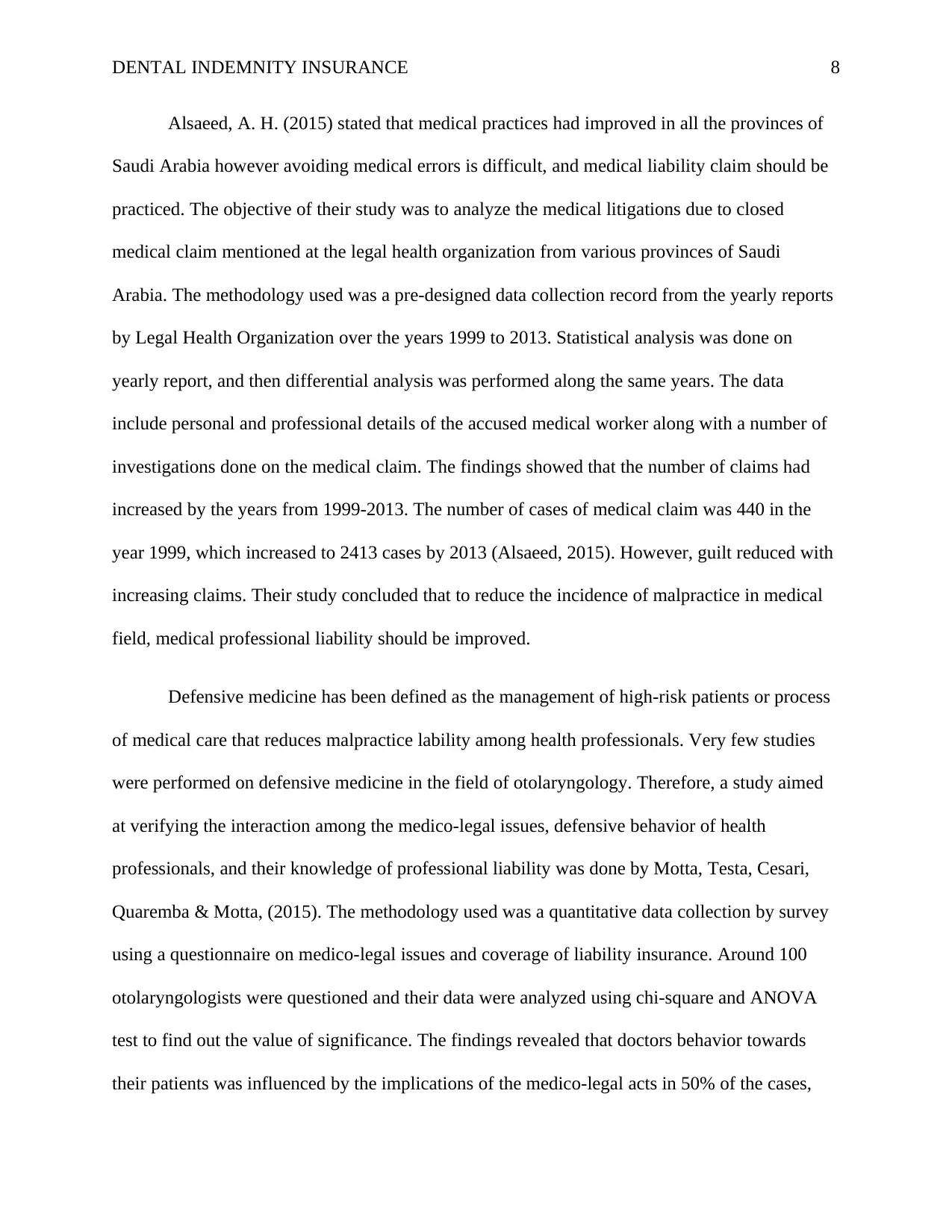
DENTAL INDEMNITY INSURANCE 8
Alsaeed, A. H. (2015) stated that medical practices had improved in all the provinces of
Saudi Arabia however avoiding medical errors is difficult, and medical liability claim should be
practiced. The objective of their study was to analyze the medical litigations due to closed
medical claim mentioned at the legal health organization from various provinces of Saudi
Arabia. The methodology used was a pre-designed data collection record from the yearly reports
by Legal Health Organization over the years 1999 to 2013. Statistical analysis was done on
yearly report, and then differential analysis was performed along the same years. The data
include personal and professional details of the accused medical worker along with a number of
investigations done on the medical claim. The findings showed that the number of claims had
increased by the years from 1999-2013. The number of cases of medical claim was 440 in the
year 1999, which increased to 2413 cases by 2013 (Alsaeed, 2015). However, guilt reduced with
increasing claims. Their study concluded that to reduce the incidence of malpractice in medical
field, medical professional liability should be improved.
Defensive medicine has been defined as the management of high-risk patients or process
of medical care that reduces malpractice lability among health professionals. Very few studies
were performed on defensive medicine in the field of otolaryngology. Therefore, a study aimed
at verifying the interaction among the medico-legal issues, defensive behavior of health
professionals, and their knowledge of professional liability was done by Motta, Testa, Cesari,
Quaremba & Motta, (2015). The methodology used was a quantitative data collection by survey
using a questionnaire on medico-legal issues and coverage of liability insurance. Around 100
otolaryngologists were questioned and their data were analyzed using chi-square and ANOVA
test to find out the value of significance. The findings revealed that doctors behavior towards
their patients was influenced by the implications of the medico-legal acts in 50% of the cases,
Alsaeed, A. H. (2015) stated that medical practices had improved in all the provinces of
Saudi Arabia however avoiding medical errors is difficult, and medical liability claim should be
practiced. The objective of their study was to analyze the medical litigations due to closed
medical claim mentioned at the legal health organization from various provinces of Saudi
Arabia. The methodology used was a pre-designed data collection record from the yearly reports
by Legal Health Organization over the years 1999 to 2013. Statistical analysis was done on
yearly report, and then differential analysis was performed along the same years. The data
include personal and professional details of the accused medical worker along with a number of
investigations done on the medical claim. The findings showed that the number of claims had
increased by the years from 1999-2013. The number of cases of medical claim was 440 in the
year 1999, which increased to 2413 cases by 2013 (Alsaeed, 2015). However, guilt reduced with
increasing claims. Their study concluded that to reduce the incidence of malpractice in medical
field, medical professional liability should be improved.
Defensive medicine has been defined as the management of high-risk patients or process
of medical care that reduces malpractice lability among health professionals. Very few studies
were performed on defensive medicine in the field of otolaryngology. Therefore, a study aimed
at verifying the interaction among the medico-legal issues, defensive behavior of health
professionals, and their knowledge of professional liability was done by Motta, Testa, Cesari,
Quaremba & Motta, (2015). The methodology used was a quantitative data collection by survey
using a questionnaire on medico-legal issues and coverage of liability insurance. Around 100
otolaryngologists were questioned and their data were analyzed using chi-square and ANOVA
test to find out the value of significance. The findings revealed that doctors behavior towards
their patients was influenced by the implications of the medico-legal acts in 50% of the cases,
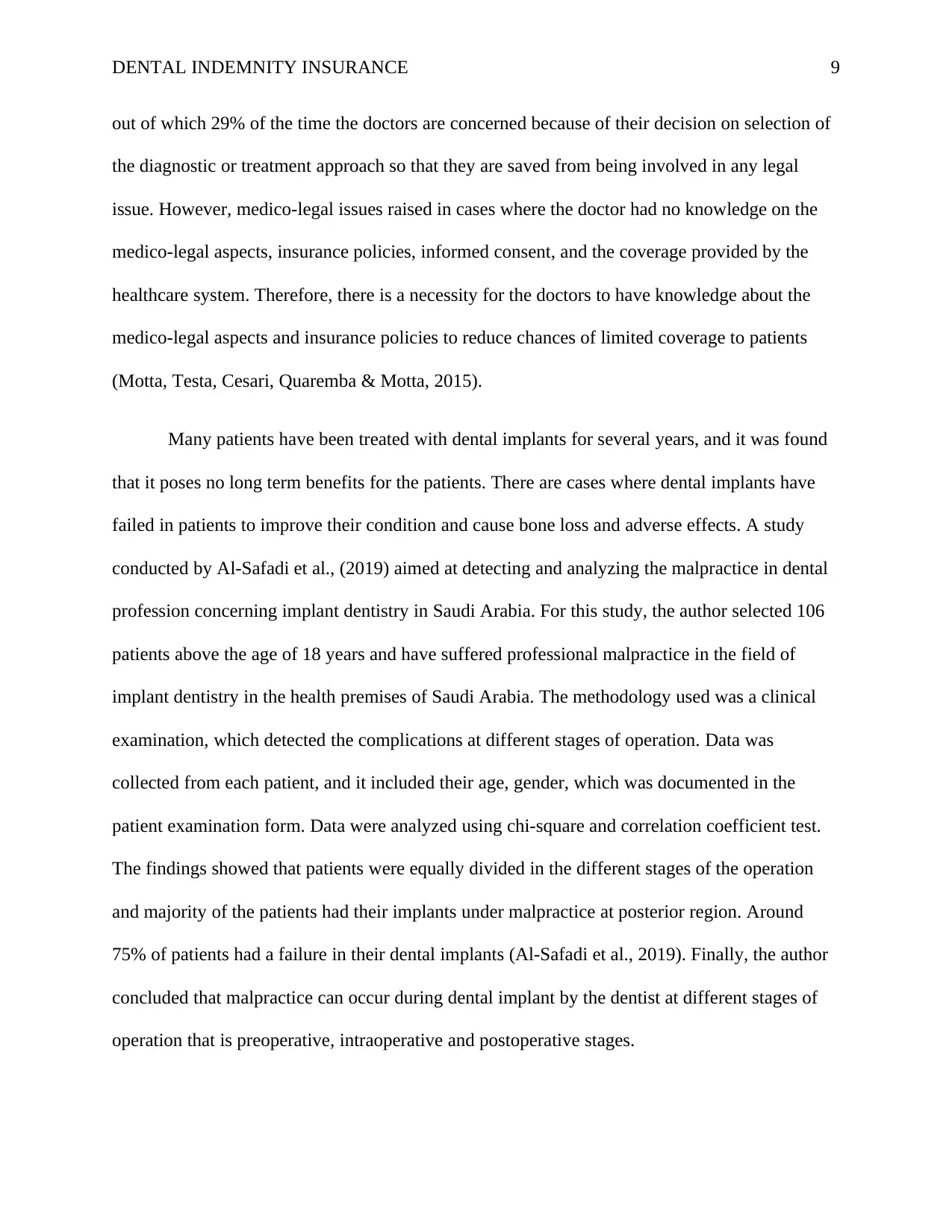
DENTAL INDEMNITY INSURANCE 9
out of which 29% of the time the doctors are concerned because of their decision on selection of
the diagnostic or treatment approach so that they are saved from being involved in any legal
issue. However, medico-legal issues raised in cases where the doctor had no knowledge on the
medico-legal aspects, insurance policies, informed consent, and the coverage provided by the
healthcare system. Therefore, there is a necessity for the doctors to have knowledge about the
medico-legal aspects and insurance policies to reduce chances of limited coverage to patients
(Motta, Testa, Cesari, Quaremba & Motta, 2015).
Many patients have been treated with dental implants for several years, and it was found
that it poses no long term benefits for the patients. There are cases where dental implants have
failed in patients to improve their condition and cause bone loss and adverse effects. A study
conducted by Al-Safadi et al., (2019) aimed at detecting and analyzing the malpractice in dental
profession concerning implant dentistry in Saudi Arabia. For this study, the author selected 106
patients above the age of 18 years and have suffered professional malpractice in the field of
implant dentistry in the health premises of Saudi Arabia. The methodology used was a clinical
examination, which detected the complications at different stages of operation. Data was
collected from each patient, and it included their age, gender, which was documented in the
patient examination form. Data were analyzed using chi-square and correlation coefficient test.
The findings showed that patients were equally divided in the different stages of the operation
and majority of the patients had their implants under malpractice at posterior region. Around
75% of patients had a failure in their dental implants (Al-Safadi et al., 2019). Finally, the author
concluded that malpractice can occur during dental implant by the dentist at different stages of
operation that is preoperative, intraoperative and postoperative stages.
out of which 29% of the time the doctors are concerned because of their decision on selection of
the diagnostic or treatment approach so that they are saved from being involved in any legal
issue. However, medico-legal issues raised in cases where the doctor had no knowledge on the
medico-legal aspects, insurance policies, informed consent, and the coverage provided by the
healthcare system. Therefore, there is a necessity for the doctors to have knowledge about the
medico-legal aspects and insurance policies to reduce chances of limited coverage to patients
(Motta, Testa, Cesari, Quaremba & Motta, 2015).
Many patients have been treated with dental implants for several years, and it was found
that it poses no long term benefits for the patients. There are cases where dental implants have
failed in patients to improve their condition and cause bone loss and adverse effects. A study
conducted by Al-Safadi et al., (2019) aimed at detecting and analyzing the malpractice in dental
profession concerning implant dentistry in Saudi Arabia. For this study, the author selected 106
patients above the age of 18 years and have suffered professional malpractice in the field of
implant dentistry in the health premises of Saudi Arabia. The methodology used was a clinical
examination, which detected the complications at different stages of operation. Data was
collected from each patient, and it included their age, gender, which was documented in the
patient examination form. Data were analyzed using chi-square and correlation coefficient test.
The findings showed that patients were equally divided in the different stages of the operation
and majority of the patients had their implants under malpractice at posterior region. Around
75% of patients had a failure in their dental implants (Al-Safadi et al., 2019). Finally, the author
concluded that malpractice can occur during dental implant by the dentist at different stages of
operation that is preoperative, intraoperative and postoperative stages.
⊘ This is a preview!⊘
Do you want full access?
Subscribe today to unlock all pages.

Trusted by 1+ million students worldwide
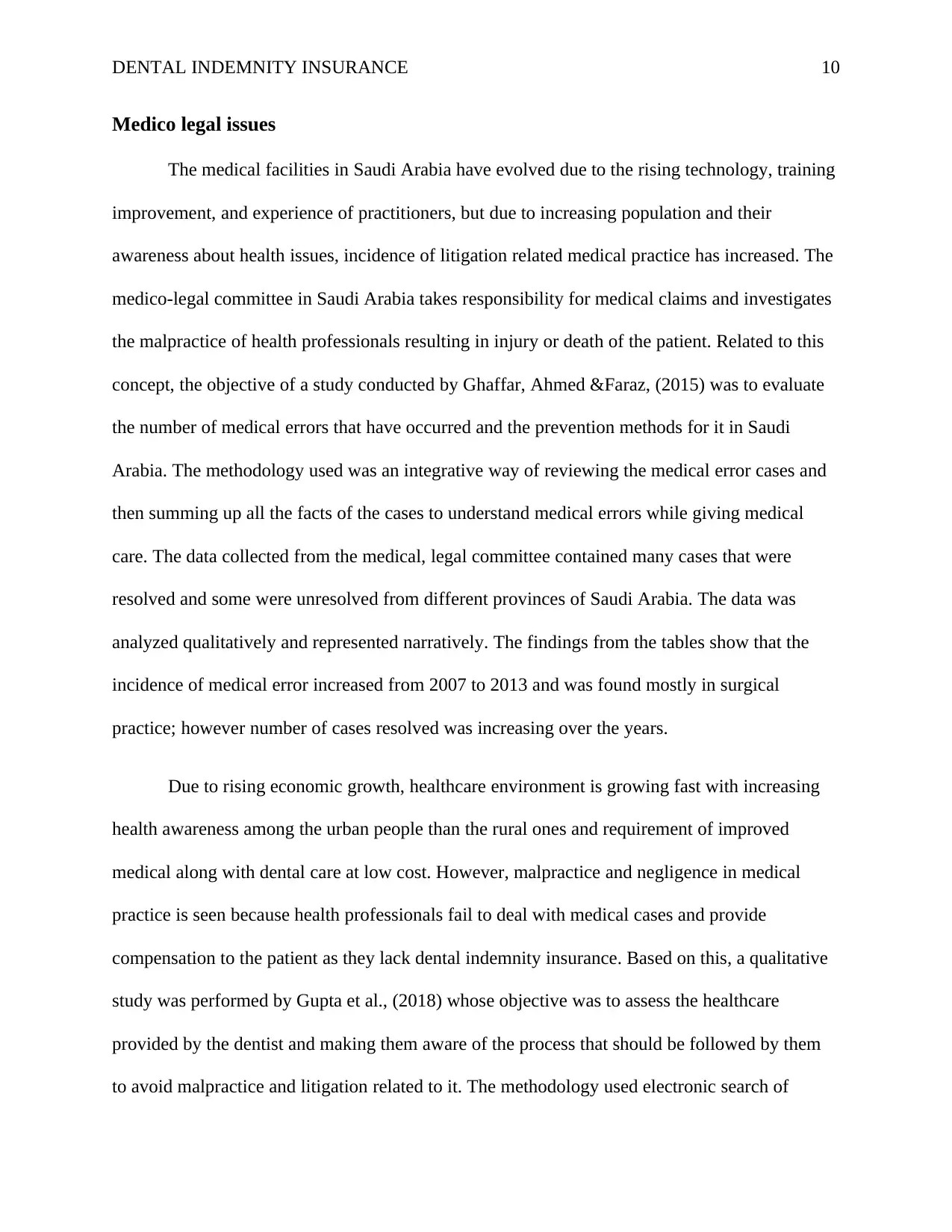
DENTAL INDEMNITY INSURANCE 10
Medico legal issues
The medical facilities in Saudi Arabia have evolved due to the rising technology, training
improvement, and experience of practitioners, but due to increasing population and their
awareness about health issues, incidence of litigation related medical practice has increased. The
medico-legal committee in Saudi Arabia takes responsibility for medical claims and investigates
the malpractice of health professionals resulting in injury or death of the patient. Related to this
concept, the objective of a study conducted by Ghaffar, Ahmed &Faraz, (2015) was to evaluate
the number of medical errors that have occurred and the prevention methods for it in Saudi
Arabia. The methodology used was an integrative way of reviewing the medical error cases and
then summing up all the facts of the cases to understand medical errors while giving medical
care. The data collected from the medical, legal committee contained many cases that were
resolved and some were unresolved from different provinces of Saudi Arabia. The data was
analyzed qualitatively and represented narratively. The findings from the tables show that the
incidence of medical error increased from 2007 to 2013 and was found mostly in surgical
practice; however number of cases resolved was increasing over the years.
Due to rising economic growth, healthcare environment is growing fast with increasing
health awareness among the urban people than the rural ones and requirement of improved
medical along with dental care at low cost. However, malpractice and negligence in medical
practice is seen because health professionals fail to deal with medical cases and provide
compensation to the patient as they lack dental indemnity insurance. Based on this, a qualitative
study was performed by Gupta et al., (2018) whose objective was to assess the healthcare
provided by the dentist and making them aware of the process that should be followed by them
to avoid malpractice and litigation related to it. The methodology used electronic search of
Medico legal issues
The medical facilities in Saudi Arabia have evolved due to the rising technology, training
improvement, and experience of practitioners, but due to increasing population and their
awareness about health issues, incidence of litigation related medical practice has increased. The
medico-legal committee in Saudi Arabia takes responsibility for medical claims and investigates
the malpractice of health professionals resulting in injury or death of the patient. Related to this
concept, the objective of a study conducted by Ghaffar, Ahmed &Faraz, (2015) was to evaluate
the number of medical errors that have occurred and the prevention methods for it in Saudi
Arabia. The methodology used was an integrative way of reviewing the medical error cases and
then summing up all the facts of the cases to understand medical errors while giving medical
care. The data collected from the medical, legal committee contained many cases that were
resolved and some were unresolved from different provinces of Saudi Arabia. The data was
analyzed qualitatively and represented narratively. The findings from the tables show that the
incidence of medical error increased from 2007 to 2013 and was found mostly in surgical
practice; however number of cases resolved was increasing over the years.
Due to rising economic growth, healthcare environment is growing fast with increasing
health awareness among the urban people than the rural ones and requirement of improved
medical along with dental care at low cost. However, malpractice and negligence in medical
practice is seen because health professionals fail to deal with medical cases and provide
compensation to the patient as they lack dental indemnity insurance. Based on this, a qualitative
study was performed by Gupta et al., (2018) whose objective was to assess the healthcare
provided by the dentist and making them aware of the process that should be followed by them
to avoid malpractice and litigation related to it. The methodology used electronic search of
Paraphrase This Document
Need a fresh take? Get an instant paraphrase of this document with our AI Paraphraser
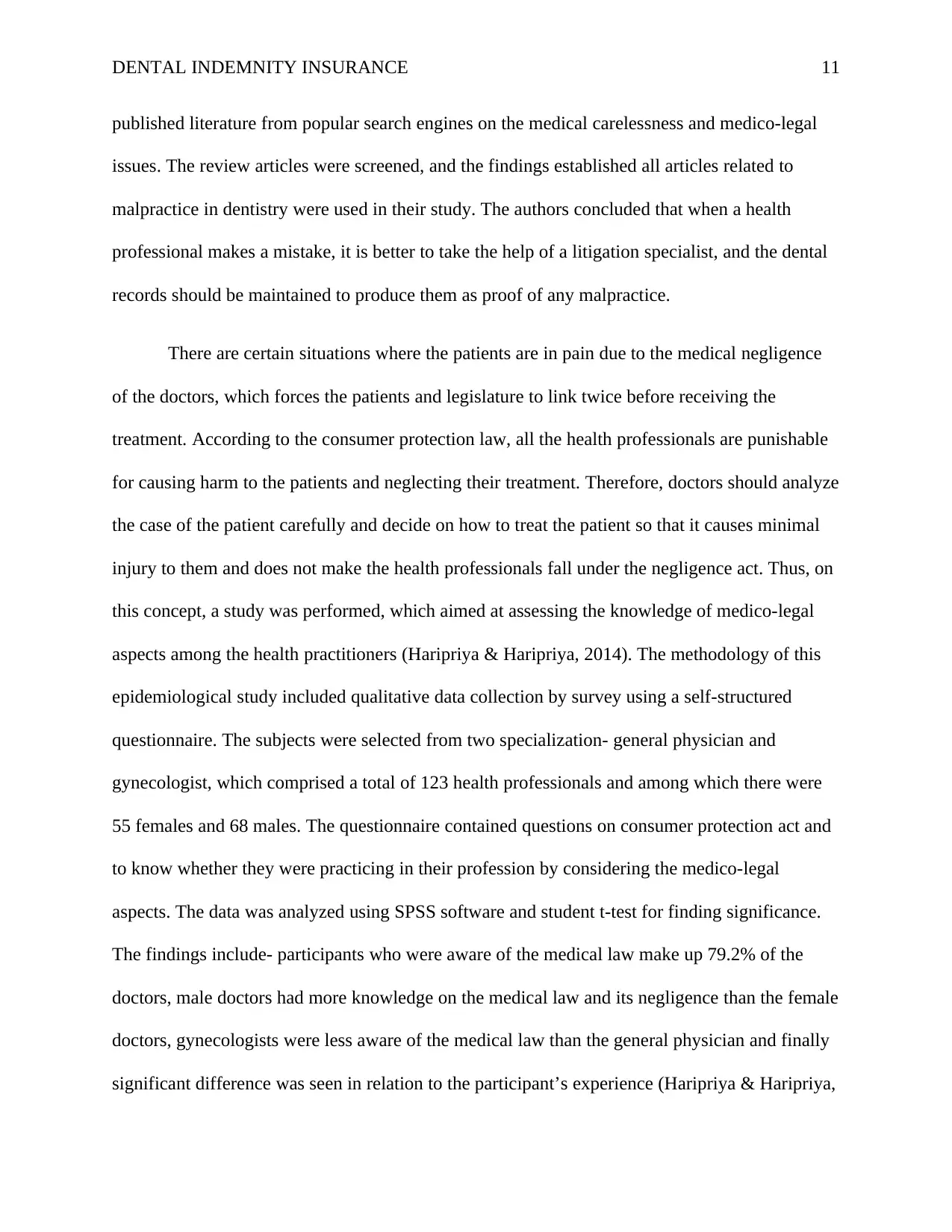
DENTAL INDEMNITY INSURANCE 11
published literature from popular search engines on the medical carelessness and medico-legal
issues. The review articles were screened, and the findings established all articles related to
malpractice in dentistry were used in their study. The authors concluded that when a health
professional makes a mistake, it is better to take the help of a litigation specialist, and the dental
records should be maintained to produce them as proof of any malpractice.
There are certain situations where the patients are in pain due to the medical negligence
of the doctors, which forces the patients and legislature to link twice before receiving the
treatment. According to the consumer protection law, all the health professionals are punishable
for causing harm to the patients and neglecting their treatment. Therefore, doctors should analyze
the case of the patient carefully and decide on how to treat the patient so that it causes minimal
injury to them and does not make the health professionals fall under the negligence act. Thus, on
this concept, a study was performed, which aimed at assessing the knowledge of medico-legal
aspects among the health practitioners (Haripriya & Haripriya, 2014). The methodology of this
epidemiological study included qualitative data collection by survey using a self-structured
questionnaire. The subjects were selected from two specialization- general physician and
gynecologist, which comprised a total of 123 health professionals and among which there were
55 females and 68 males. The questionnaire contained questions on consumer protection act and
to know whether they were practicing in their profession by considering the medico-legal
aspects. The data was analyzed using SPSS software and student t-test for finding significance.
The findings include- participants who were aware of the medical law make up 79.2% of the
doctors, male doctors had more knowledge on the medical law and its negligence than the female
doctors, gynecologists were less aware of the medical law than the general physician and finally
significant difference was seen in relation to the participant’s experience (Haripriya & Haripriya,
published literature from popular search engines on the medical carelessness and medico-legal
issues. The review articles were screened, and the findings established all articles related to
malpractice in dentistry were used in their study. The authors concluded that when a health
professional makes a mistake, it is better to take the help of a litigation specialist, and the dental
records should be maintained to produce them as proof of any malpractice.
There are certain situations where the patients are in pain due to the medical negligence
of the doctors, which forces the patients and legislature to link twice before receiving the
treatment. According to the consumer protection law, all the health professionals are punishable
for causing harm to the patients and neglecting their treatment. Therefore, doctors should analyze
the case of the patient carefully and decide on how to treat the patient so that it causes minimal
injury to them and does not make the health professionals fall under the negligence act. Thus, on
this concept, a study was performed, which aimed at assessing the knowledge of medico-legal
aspects among the health practitioners (Haripriya & Haripriya, 2014). The methodology of this
epidemiological study included qualitative data collection by survey using a self-structured
questionnaire. The subjects were selected from two specialization- general physician and
gynecologist, which comprised a total of 123 health professionals and among which there were
55 females and 68 males. The questionnaire contained questions on consumer protection act and
to know whether they were practicing in their profession by considering the medico-legal
aspects. The data was analyzed using SPSS software and student t-test for finding significance.
The findings include- participants who were aware of the medical law make up 79.2% of the
doctors, male doctors had more knowledge on the medical law and its negligence than the female
doctors, gynecologists were less aware of the medical law than the general physician and finally
significant difference was seen in relation to the participant’s experience (Haripriya & Haripriya,
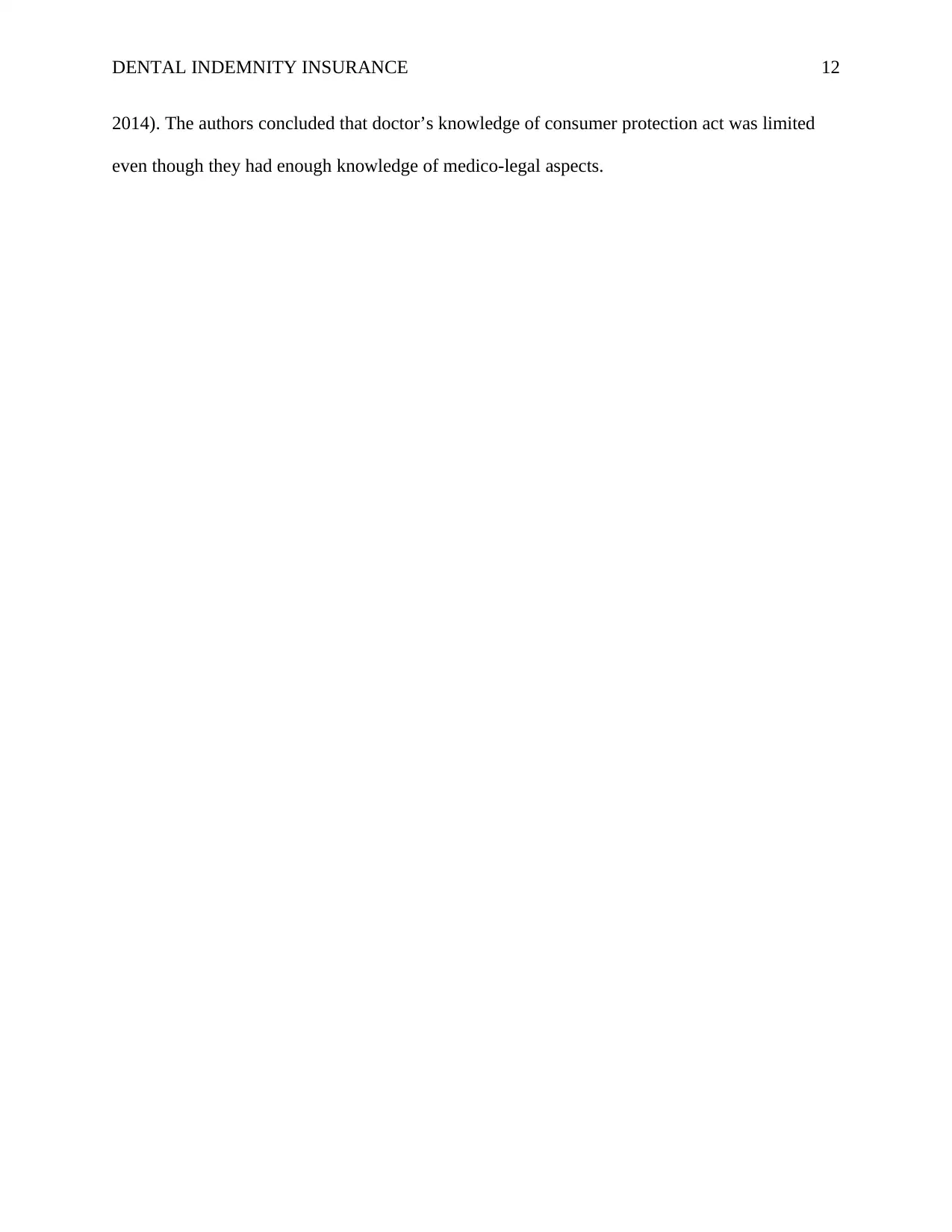
DENTAL INDEMNITY INSURANCE 12
2014). The authors concluded that doctor’s knowledge of consumer protection act was limited
even though they had enough knowledge of medico-legal aspects.
2014). The authors concluded that doctor’s knowledge of consumer protection act was limited
even though they had enough knowledge of medico-legal aspects.
⊘ This is a preview!⊘
Do you want full access?
Subscribe today to unlock all pages.

Trusted by 1+ million students worldwide
1 out of 16
Related Documents
Your All-in-One AI-Powered Toolkit for Academic Success.
+13062052269
info@desklib.com
Available 24*7 on WhatsApp / Email
![[object Object]](/_next/static/media/star-bottom.7253800d.svg)
Unlock your academic potential
Copyright © 2020–2025 A2Z Services. All Rights Reserved. Developed and managed by ZUCOL.





